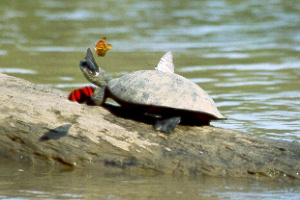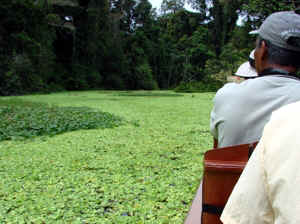

Destinations
Experiences
 |
L A
D A T C O T O U R
S |
 |
||||||||
| HOME | South America | Falkland Islands | Antarctica | Unique Destinations |
Unique Experiences |
Newsstand | ||||
 |
ABOUT RAINFORESTS Rainforest Basics Rainforest Destinations Rainforest Experiences |
 |
WHAT IS A RAINFOREST?
From "The Neotropical Companion" by John Kricher:
A rainforest is essentially a non-seasonal forest, where rainfall is both abundant and constant.
IS THERE A DIFFERENCE BETWEEN A JUNGLE AND A RAINFOREST?
From "The Neotropical Companion" by John Kricher:
When a rainforest is disturbed, such as by hurricane, lightning strikes or human activity,
the disturbed area is opened, permitting the penetration of large amounts of light.Fast growing plant species intolerant of shade are temporarily favored
and a tangle of thin-boled trees, shrubs and vines result.Like a huge, dense pile carpet, a mass of greenery, or "jungle",
soon covers the gap created by the disturbance.
Another explanation:
A tropical rainforest has more kinds of trees and other plant life than any other area of the world. Most trees in the tropical rainforest are broad leaf trees that grow closely together. The tallest trees may grow as tall as 200 feet. The tops, called crowns, form a covering of leaves about 100-150 feet above the ground. This cover is called the upper canopy. The crowns of the smaller trees form one or two lower canopies. These canopies share the forest floor so that it receives less than one percent as much sunlight as does the upper canopy. As a result, only ferns and other plants requiring little sunlight grown on the forest floor. This makes it possible for a person to easily walk through most parts of a tropical rainforest.
However, areas of dense growth occur where much sunlight reaches the ground. These areas are called jungles and grow in swamps, near broad rivers or in former clearings.
| According to www.dictionary.com whose source is Webster's Revised
Unabridged Dictionary, the definition of "amazon" is:
|
According to WordNet, the
definition of "amazon" is:
|
According to Webster's New
Twentieth Century Dictionary Unabridged Second Edition:
|
You will note that NONE of the definitions associate "jungle" or "rainforest" with the definition of Amazon.
However, in everyday language "amazon" most commonly refers as equally to "rainforest" and-or "jungle" as it does to the actual river and river basin itself.
So, is the Amazon a "rainforest" or a "jungle"?
Both, depending on where you are in the Amazon.
According to Grolier Inc, there are two major types of rainforests:
- tropical, characterized by broadleaf evergreen trees that form a closed canopy, below which is found a zone of vines and epiphytes (plants growing in the trees), a relatively open forest floor and a very large number of species of both plant and animal life. The largest areas of the tropical rainforest are in the Amazon basic of South America, in the Congo basin and other lowland equatorial regions of Africa, and on both the mainland and the islands off Southeast Asia where they are especially abundant in Sumatra and New Guinea. Small areas are found in Central America and along the Queensland coast of Australia.
- temperate, growing in higher-latitude regions having wet, maritime climates and less extensive than those of the tropical forests. Some of the notable forests in this category are the northwest of the USA, southern Chile, in Tasmania and in parts of southeastern Australia and New Zealand.
| WHERE ARE THE RAINFORESTS OF THE WORLD? According to International Preservation in 1997: Among the world's 200 nations, just 17 are home to 70% of all of the biodiversity, the natural riches of the planet. Of these 17 mega-diverse countries, 7 are in the Western Hemisphere and 5 are in South America. |
WHERE ARE THE RAINFORESTS OF SOUTH AMERICA? Most of Central America has rainforests.
|
SOME RAINFOREST QUICK FACTS found in a variety of places, simplified and organized, sometimes with diverse stats and certainly NOT meant to be a definitive guide:
Brazil - #1 in bio-diversity,
according to International Preservation in 1997:
Colombia:
Ecuador was added to the mega-biodiversity list because of the variety of eco-systems and diversity due to the Galapagos |
Peru:
|
Miscellaneous and un-organized but interesting facts:
- rain forests cover less than 6% of the earth's total land surface
- rainforests are home for up to three-fourths of all known species of plans and animals
- rain forests have three to four different levels:
- emergent layer (top most level; tops of the tallest trees as tall as 150 feet)
- the canopy (tops of trees ranging 60-90 feet tall)
- the understory (trees of up to 50 feet tall; trunks of canopy trees; new trees)
- the forest floor (branches, roots, leaves, little vegetation, thin layer of soil)
- 1/3 of all the birds in the world live in rainforests
- In Central America, a scientist caught over 500 different species of insects by sweeping a net through the air fewer than 2000 times
- In stead of wind, many hummingbirds, other birds, bats and insects are the main source of spreading seeds throughout the forest floor
- Frogs in the rainforest are very bright and shiny
- A rainforest can have more ants, in weight and numbers, than anything else
- 30 million species of plants and animals liver in the world's rainforests
- Two thirds of the world's plants are found in the rainforest
- 30,000 types of species of epiphytes (some examples: bromeliads, mosses, ferns, orchids, cacti)
- Thundershowers, on average, occur 200 out of 365 days a year which creates a very humid atmosphere
AMAZON QUICK FACTS obtained from a variety of sources, simply organized, none verified and not meant to be the definitive guide to Amazon facts.
|